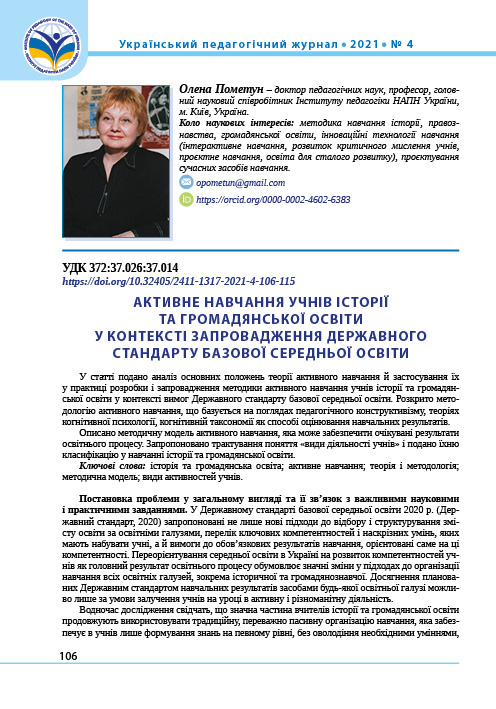Abstract
The article analyzes the main provisions of the theory of active learning and their application in the practice of developing and implementing the methodology of active learning of history and civic education courses in the context of the requirements of the State Standard of Basic Secondary Education. The author proceeds from the fact that the achievement of the expected learning outcomes determined by the State Standard by means of any educational branch can be provided only on condition of involvement of students at a lesson in various and engaging activities. We understand an engaging activity as a way/organization of learning when students – subjects of the educational process play an active role in it, and the teacher is only the organizer of students’ activities, facilitator and moderator of the discussion. The process of active learning provides students to learn by answering and asking questions, analyzing facts and arguments, linking new information with previously gained knowledge, formulating conclusions and reflecting on new ideas. The methodology of active learning is based on the views of pedagogical constructivism, theories of cognitive psychology, cognitive taxonomy as a way to describe learning outcomes.
The article describes the model of active learning that can provide the expected learning outcomes of the educational process. It involves thorough planning of the expected learning outcomes by the teacher, organizing active learning in such a way (using different activities of students) to create the space for independent thinking and decisions of each child, providing the positive classroom climate that will create emotional incentives for successful learning.
The author proposes the interpretation of the concept of “types of student activities” and presents their classification in learning history and civic education courses, in particular, these are the groups of student activities that are the most important today to ensure the formation of students’ competencies: students’ activities using ICT, discussion, investigation and experimentation, cooperative and interactive learning. To make an effective choice of activities, the teacher should carefully consider the expected learning outcomes he/she wants students to achieve, the composition and capabilities of the particular students’ group, the existing conditions of the learning environment, time limits and logistics of the educational process. The role of the teacher in this approach is primarily related to organization and management.

This work is licensed under a Creative Commons Attribution-NonCommercial-ShareAlike 4.0 International License.
Copyright (c) 2021 Олена Пометун

